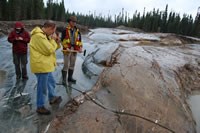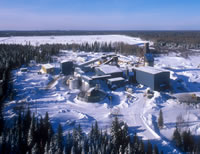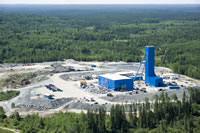The global turmoil in financial markets and the abrupt collapse of commodity prices have taken some of the shine off the mining and mineral exploration sectors, but it’s a different story for gold. True, exploration programs for precious metals have also been trimmed and financing is a challenge, however, the consensus among market observers is that gold is poised for an upswing.
"With lower base metal prices, it’s tougher for exploration companies to find people who are willing to invest, so their funding has dried up, but gold is seen as a safe haven when markets are volatile and it’s a hedge against inflation," said Trevor Turnbull, director of gold and precious metals with Scotia Capital.
Given the unprecedented volatility sweeping the world, market watchers expected gold prices to shoot up a lot earlier, but "the safe haven these days for investors is to be out of the market and to have cash," said Turnbull. "People have been afraid to put their money to work, but we think that when they start to look for places to invest, they’re going to turn to gold."
The surprising strength of the U.S. dollar acted as a brake on the price of gold in the final quarter of 2008 and into January. However, most observers think it’s just a matter of time before the dollar succumbs to the pressures building against it and, once it does, gold will take off.
The greenback is artificially high in spite of the increase in the money supply because nervous investors have pulled money out of the stock markets and created "a huge demand to hold U.S. dollars," explained Turnbull. Gold has maintained its value during this period because "people see that the dollar’s days are numbered.
$1,000 an ounce
"With gold moving higher, I think junior mining companies will be able to raise financing. It won’t be quite as simple as it was in the past when everything looked good, but they will definitely attract exploration dollars as we see the price of gold pushing through $1,000 an ounce.
"We’ve seen many more companies come to market in the last six to eight weeks and not have too much trouble attracting investors, so I think there’s a window here where exploration companies can raise money and should probably take advantage of it."
Rising inflation triggered by the massive stimulus being injected into the economy by the U.S., Europe, China and other countries, including Canada, will be another boost for gold, said Turnbull.
Higher gold prices expected to fuel exploration
All of this is good news for dozens of mining and exploration companies in Northern Ontario, from Red Lake in the northwest to Timmins and Kirkland Lake in the northeast.
Lake Shore Gold
No one is more excited about the prospect of gold pushing through the $1,000 an ounce mark as the principals of Lake Shore Gold Corp., which is on its way to becoming the next producing mine in the Timmins area.
The junior miner’s Timmins project, located 18 kilometres west of the city, has 1.2 million ounces (uncut) of reserves with a grade of 10.4 grams per tonne.
The 2004 discovery occurs immediately north of the Destor-Porcupine fault and west of the Mattagami River fault system. Little past exploration has been conducted in the area, suggesting tremendous exploration upside, said Mark Utting, vice president, investor relations.
The deposit consists of five main ore lenses trending northwest-southeast, dipping steeply to the north and plunging to the northwest. Based on drilling to date, the deposit has been defined to a vertical depth of 1,200 metres below surface and is still open along strike to the west and to depth.
Development work began last fall for the fully permitted two-phase project.
Phase one involves the construction of a surface ramp to 400 metres, where underground mapping, sampling and exploration drilling will occur. It is slated to produce about 30,000 ounces beginning in the first quarter of 2009, although some test batches have already been put through the company’s refurbished Bell Creek mill, according to Eric Kallio, vice president of exploration.
Phase two involves the development of a shaft to a depth of 750 metres by year’s end, producing 100,000 ounces.
Refurbishment of the company’s Bell Creek mill has been going well. Its capacity is 1,500 tonnes per day, with room for expansion. Some pre-production ore was processed and the first gold bar poured on December 31, 2008.
Spending for 2008 was $75 million, including exploration. Approximately $82 million has been budgeted for 2009.
Exploration drilling is continuing at the Bell Creek Complex to bring that historic resource into 43-101 compliant reserves on the Bell Creek, Vogel and Schumacher properties, which are adjacent to Goldcorp’s producing Hoyle Pond mine. Assay results are showing high-grade mineralization as they continue looking for new south zones. The study for the Vogel ramp is targeted for completion in the first quarter of 2009.
The company’s 22,000-metre drill program recently announced "high-grade" gold intercepts on its Thunder Creek joint venture property next to its Timmins project. According to Utting, this property has significant potential to be another "very attractive deposit.
"You can’t be in a better place to develop a mine as far as we’re concerned," he said.
Detour Gold
Also in the northeast, Detour Gold Corporation has been aggressively setting the stage for a potential open-pit operation at the former Placer Dome mine.
A reassessment of the former pit’s resource based on a US$700 gold price puts the Detour Lake resource at 13.2 million ounces, of which 10.8 million ounces are measured and indicated, with an average grade of 1.3 grams per tonne.
"It is a fully-engineered pit," said Laurie Gaborit, Detour Gold’s director of investor relations. "There is quite a potential to grow the resource because the deposit is open to the west."
The company has invested $43 million and drilled in excess of 230,000 metres, with about 20,000 metres to go. Gaborit said the company has budgeted between $10 million and $15 million, which includes current drilling and the completion of a feasibility study by September 2009.
Kirkland Lake Gold
Further south, Kirkland Lake Gold Inc. has set aside $40 million for capital and $80 million for operating expenses toward an 18-month project that will bring its new South Mine Complex (SMC) into production.
Plans are underway to double current production levels to a rate of 100,000 ounces a year beginning in March, said Mark Tessier, vice president of operations.
Tessier said it is a big step forward for the company, which has not been operating in the black since the mine reopened in 2003.
"I was brought in to bring the mine from an exploration stage with some production into an ongoing exploration phase with profitable production," he remarked.
The company’s resources and reserves total three million ounces, half of which are in the SMC with an average grade of 0.7 ounces per ton. The 2006 discovery consists of 15 or more mineralized zones, open in all directions, said Gary Grabowski, Kirkland Lake’s regional resident geologist.
A new haulage conveyor system will be installed and run down to depth and further east to increase efficiencies in the old track mine. Tessier also hopes to eventually run the mill to its 1,450 ton per day capacity as production increases. The development work will be performed by its current 234-person workforce, which is being increased by approximately 150 people.
The present exploration budget of $6.3 million will run until the close of the 2009 fiscal year in April, when a new budget will be approved.
Queenston Mining
Adjacent to that property is the company’s joint venture project with Queenston Mining Inc. A 2007 underground and surface exploration program intersected the down-dip extension of the SMC on the property, proving up indicated and inferred mineral resources.
At the December 2008 Ontario Prospectors Association symposium in Sudbury, Queenston Mining’s CEO and president Charles Page presented the company’s steadily increasing 43-101 resources and reserves on its four Gauthier Township properties, totalling just over two million ounces.
In 2008, Queenston spent about $8 million on exploration and is continuing to report intersections of multiple zones of gold mineralization on its McBean property.
With about $19 million in working capital, Page said the four Gauthier Township properties are advancing toward production over the next three years with the idea to build a central mill at the Upper Canada site, where a tailings pond already exists.
Apollo Gold
Another bright spot in the northeast is Apollo Gold’s Black Fox open-pit mine in Matheson, about 75 kilometres east of Timmins.
This U.S.-based company’s 1,000-hectare land package has seen more than 230,000 metres of both surface and underground drilling, resulting in a current reserve estimate of 1,330,000 ounces of gold.
A full feasibility study was completed in April 2008 and all permits and approvals are in place. The purchase of St. Andrew Goldfield’s Stock Mill has helped speed up the company’s production goals, said Grabowski. The company is spending $21 million to upgrade the mill, which will process a minimum of 1,500 tonnes of ore per day.
Although development of the underground workings has been put on hold, the company is going ahead with site-prep work for its open pit. Access and mine haul roads have been built and the overburden will be gone by spring. Bridge financing of US$15 million announced in December will keep Apollo Gold on schedule for an April production start.
The company is on a hiring blitz, with plans to recruit between 150 and 200 people.
"It is a very good property and it has been a long time coming," said project manager Ryan Lougheed. The open-pit’s 10-year mine life will be a solid contributor to the surrounding community, he added.
Northgate Minerals
Another mid-tier miner developing property in the Matachewan area is Vancouver-based Northgate Minerals Corporation. This gold and copper producer in Canada and Australia recently doubled its total gold resource base at its Young-Davidson property to more than four million ounces.
Located 60 kilometres west of Kirkland Lake, this 11,000-acre property is the site of two past-producing mines. Northgate acquired the property in 2005 for $18 million and is targeting first production by early 2011.
Its 2008 underground exploration and development work took the project closer to the permitting stage.
Apollo Gold on schedule for April production startup
A preliminary economic assessment was filed in August incorporating its new resource. Once completed, a full feasibility study will be commissioned. The company has set aside $8.6 million for its 2009 budget, of which $1.2 million is slated for exploration. The balance will be for permitting, engineering and feasibility studies.
Northwest
Gold exploration activity in northwestern Ontario has moderated somewhat as a result of the turmoil impacting financial markets, but "the way I look at it, it’s more like a normal year," said Mark Smyk, regional resident geologist for the Thunder Bay North District. "It has been so exceptionally busy the last few years that when things slow down to this extent, people think it’s a real setback, but it’s just a reasonable level of activity as opposed to a crazy level.
"We had consultants with their phones ringing off the walls. Now, they’re out looking for work as they would in a normal year. People I talk to say there’s work out there, but it’s three weeks here and a month there. You can keep yourself busy, but it’s going to take a little more effort."
There used to be a waiting list to get a drill. Now, said Smyk, drillers are calling looking for contracts.
Geraldton camp
The resurgence of the Geraldton camp is one of the most exciting developments in the northwest. Premier Gold Mines Limited, a major player in the camp, has committed to spend between $8 million and $10 million this year on its Hardrock project, operated under a joint venture with Roxmark Mines. It has plans for 50,000 metres of drilling and had three drills in place as of the end of January.
Three past producing mines in the camp produced more than two million ounces of gold between 1938 and 1968, but very little work has been done in the area in the last 40 years, said Smyk.
"Premier Gold is bullish on the idea that this camp can stand some new, modern exploration and they have both the financial resources and the desire to do a nice systematic approach to see what they can come up with.
"When these mines closed, gold was selling for $35 an ounce, so a lot of the lower grade zones that wouldn’t have been considered back then are all of a sudden more prospective."
Drilling techniques have improved dramatically in the last 40 years and there is a much better understanding of how the gold deposits formed, which, in turn, allows for the use of predictive modelling to select new targets.
"The same thing happened in the Red Lake camp in the ’90s, said Smyk.
"It was a mine that was thought to be exhausted, but they started applying some new models and, lo and behold, you have a revitalized camp. Ewan Downie (Premier Gold’s president and CEO) sees the same kind of upside potential in Geraldton as well and it’s something we’ve been bullish on at the Ministry for a long time."
Also bullish on the Geraldton-Beardmore camp is Kodiak Exploration Limited, which had seven or eight drills testing its Hercules Gold project until recently. The company has scaled back somewhat, but still has several drills operating within its 1,400-square kilometre land package.
Musselwhite
Positive news is also coming from Goldcorp’s Musselwhite Mine north of Thunder Bay, where exploration along the strike length of the orebody has extended the mine life another 10 years.
"The mine life, based on reserves, is 2018," said Smyk. "That’s the same as they went into production with, so they’ve been able to replace all the reserves they’ve mined out. Now, they’re talking about the life of mine going to 2028."
It’s also likely that Goldcorp will sink a production shaft next year to skip ore to surface rather than haul it underground and out the portal. To date, said Smyk, Goldcorp has netted one million ounces per kilometer of strike length at Musselwhite. Recent grades, however, indicate they might double that.
Other projects of note in the northwest include PC Gold Inc.’s Pickel Crow property, a past producer from the ’60s with a brand new 250-ton per day mill, Rainy River Resources with three drills at work on its 26,000-hectare property 80 kilometres south of Kenora and Brett Resources’ Hammond Reef project near Atikokan, where a resource estimate indicates a resource of 4.8 million ounces.
Red Lake
In the Red Lake camp, Goldcorp’s has consolidated its Red Lake and Campbell operations and completed the sinking of a new 6,312-foot shaft. It continued its consolidation of landholdings late last year with the purchase of Gold Eagle Mines Ltd. and its Bruce Channel discovery for $1.5 billion, providing it with full control along eight kilometers of strike length
"Gold Eagle was just about to start blasting for their exploration shaft when the deal came through with Goldcorp," said Red Lake resident geologist Andreas Lichtblau. However, soon after completing the transaction, Goldcorp suspended work on Bruce Channel as well as several other properties in the camp to conserve cash.
"Now that Goldcorp is an international player, they have other competing projects. It’s not just a standalone like it used to be," said Lichtblau. "Now they have 10 operations all competing for the same pot of money."
Also active in the Red Lake camp is Claude Resources, which has dewatered and refurbished an existing shaft at the former producing Madsen Mine, and Rubicon Minerals, which is about to start dewatering a shaft that was never in production at its McFinlay Gold project.
These former producing mines were last worked decades ago and only the surface was touched, said Lichtblau. "Today, with modern technology and geophysics, you can see down a kilometre and deep drilling is also much more feasible," he said.
Other gold producers in the north include Richmont’s Island Gold Mine near Wawa, which was brought into production in October 2007, and the Williams and David Bell mines in Hemlo, which are jointly owned by Barrick Gold and Teck Cominco.
Stopes as wide as 30 to 40 metres at the Williams and David Bell operation are mostly mined out, said Smyk. "That kind of bulk scale underground mining is almost unheard of in the gold realm. Now, they’re mostly going after narrow, erratic, higher-grade zones and they’ve adjusted their mining methods to reflect that." In production since 1985, the Hemlo operation only has a few years of mine life remaining.
The favourable predictions for gold are good news for Northern Ontario, particularly in light of the precipitous drop in base metal prices.
"Gold has always been the mainstay of exploration in the northwest, accounting for between two-thirds and three-quarters of our activity," said Smyk. "It’s traditionally been our bright light and continues to be so."
www.lsgold.com
www.klgold.com
www.detourgold.com
www.apollogold.com
www.premiergoldmines.com
www.kodiakexp.com
www.goldcorp.com
www.pcgold.ca
www.northgateminerals.com
www.queenston.ca
www.rainyriverresources.com
www.claudseresoureces.com
www.rubiconminerals.com




